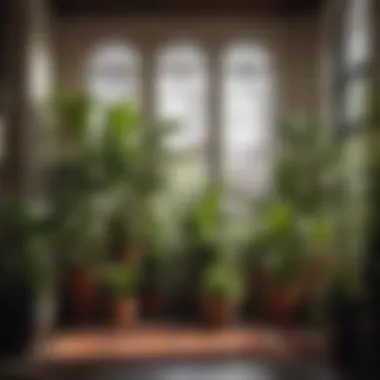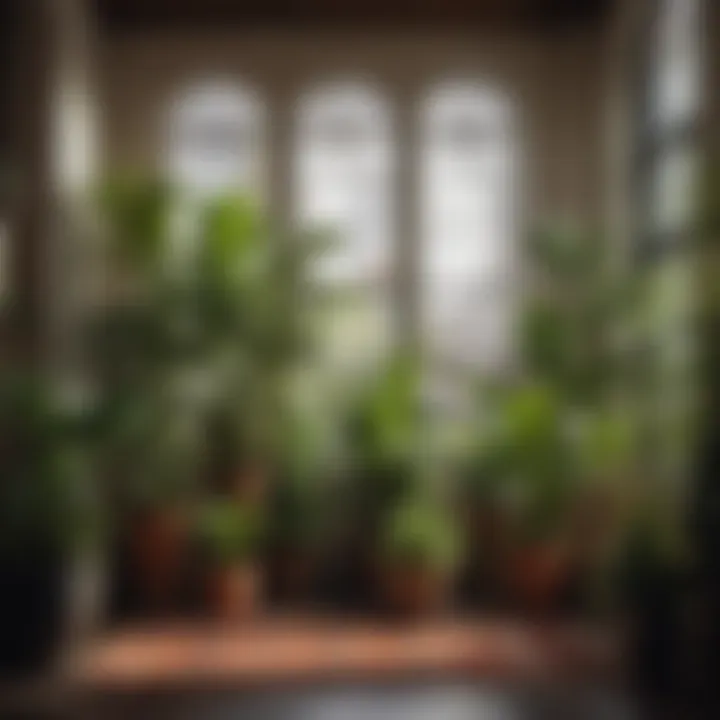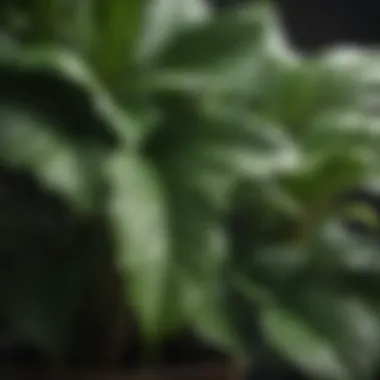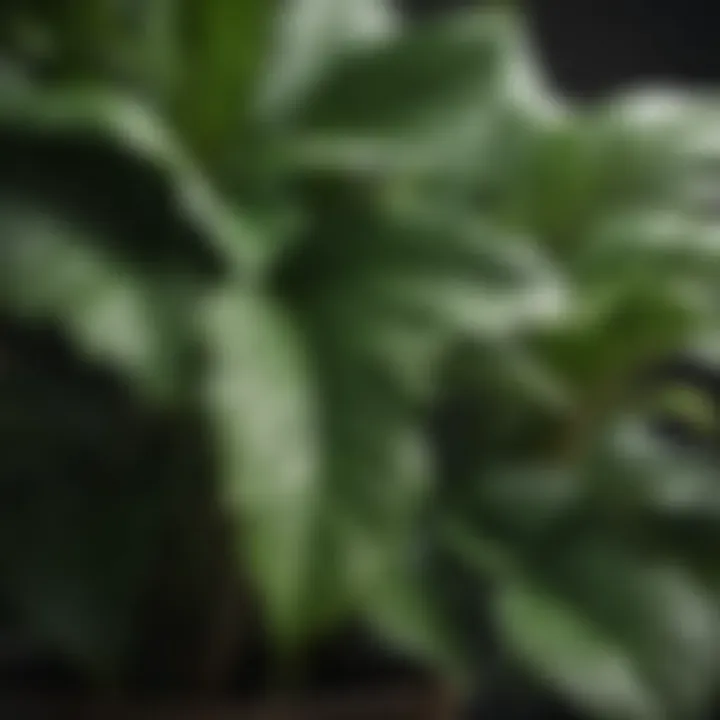Indoor Plants: Names, Care, and Benefits Explained


Intro
Indoor plants have become more than just decor items; they have transformed into crucial companions for many households. Integrating these plants into your living spaces can have profound effects on both the aesthetic appeal and the well-being of those who reside there. This guide aims to shine a light on the common indoor plants that adorn our homes, delve into their care requirements, and uncover the myriad benefits they offer.
From the striking Fiddle Leaf Fig to the humble Snake Plant, each species brings its own flavor to interior design. By understanding their characteristics and needs, you can curate an indoor garden that not only beautifies your environment but also enhances your health by purifying the air and contributing to mental wellness. As we journey through this guide, we will address various factors such as suitable planting methods, watering schedules, and light requirements.
Moreover, with the rising trend in mindful living, growing indoor plants is no longer just an aesthetic choice; it's part of a holistic approach to living well. Integrating nature into your home fosters a serene atmosphere that encourages relaxation and rejuvenation. Let’s take a closer look at the trending styles and color palettes that align beautifully with these green companions.
Understanding Indoor Plants
Indoor plants are more than just a splash of green in our homes; they represent a bridge between nature and our indoor environments. These living entities purify the air, promote well-being, and add aesthetic charm to any space. As we dive into the world of indoor plants in this guide, it is vital to recognize their significance not only as decorative pieces but also as vital contributors to a healthier living atmosphere.
Definition and Significance
Indoor plants refer to those species that thrive in controlled environments, typically homes and offices. They can range from common houseplants like the Peace Lily to exotic varieties such as the Orchid. The importance of indoor plants hinges on several aspects:
- Air Quality: Many indoor plants are renowned for their ability to filter out harmful toxins. For instance, the Snake Plant is known to absorb formaldehyde, a common indoor pollutant.
- Psychological Benefits: Studies indicate that having greenery around can reduce stress, promote calmness, and enhance productivity. This relationship between plants and mental wellness cannot be overstated.
- Aesthetic Value: Indoor plants offer a visual appeal that can transform a dull room into a vibrant space filled with life. When placed thoughtfully, they can complement your decorative choices, adding texture and color.
- Environmental Contributions: On a larger scale, indoor gardening contributes positively to the environment. It fosters a sense of responsibility towards sustainability and promotes eco-friendly practices.
Thus, understanding indoor plants opens up avenues for home decor but also nurtures a deeper appreciation for the role nature plays in our lives.
Role of Indoor Plants in Interior Design
In the realm of interior design, indoor plants play a multifaceted role, offering both functional and decorative benefits. Here are some ways in which they contribute to design:
- Focal Points: A strategically placed large monstera or a vibrant bouquet of house flowers can act as a stunning centerpiece, drawing attention and sparking conversation.
- Textural Contrast: Incorporating plants adds a layer of texture that contrasts sharply with flat surfaces, such as walls and furniture. The roughness of a cactus can juxtapose nicely with the smoothness of a wooden table.
- Color Palette Enhancement: Plants can either complement or contrast the existing color scheme of a room. A colorful plant like the African Violet could serve to brighten a dull corner.
- Creating Zones: In open spaces, indoor plants can be used to delineate areas, setting apart a cozy reading nook or a dining area visually.
"Integrating plants into interior designs isn't just about adding beauty; it’s about creating an atmosphere that nourishes the mind and spirit."
The contribution of indoor plants to interior design invites a fresh perspective on aesthetics. The interplay between flora and architecture can lead to spaces that feel not only serene but alive, enriching the human experience in those environments.
Popular Types of Indoor Plants
Indoor plants can truly transform a space, adding life and vibrancy while also serving various purposes. Understanding the different types of indoor plants is essential in maximizing the benefits they bring to your home. This section delves into popular indoor plants, focusing primarily on foliage plants, flowering varieties, and succulents. Each category comes with its unique characteristics and care requirements, making them suitable for different tastes and circumstances. By familiarizing yourself with the options available, you can select plants that not only beautify your living areas but also provide health benefits and contribute to overall well-being.
Foliage Plants
Peace Lily
The Peace Lily, with its striking white blooms and glossy green leaves, is a popular choice among indoor plant enthusiasts. It's well-loved not just for its beauty but also for its ability to improve indoor air quality. Peace Lilies are known to remove common pollutants like formaldehyde and benzene from the air. Furthermore, they thrive in low-light conditions, making them perfect for spaces that lack direct sunlight.
A unique trait of the Peace Lily is its ability to signal when it needs water; its leaves droop slightly when it requires hydration, making care easy for those new to plant parenting. However, one should be cautious; while they are excellent purifiers, the leaves are toxic if ingested, so keep them out of reach of pets and children.
Snake Plant
The Snake Plant, or Sansevieria, boasts a robust structure and striking appearance, characterized by its tall, sword-like leaves that often have variegated edges. It's one of the most forgiving houseplants for busy individuals, as it tolerates low light and infrequent watering. This resilience contributes to its rising popularity among urban dwellers with hectic lifestyles.
In addition to being low-maintenance, the Snake Plant also has air-purifying capabilities. It absorbs toxins and releases oxygen at night, ensuring clean air for your home even while you sleep. Its only downside could be its slow growth which might be a bit frustrating for those looking for quick results in their indoor gardening journey.
Pothos
Pothos, often referred to as Devil's Ivy, is known for its heart-shaped leaves and trailing vines. This plant is exceptionally versatile, adaptable to various light conditions and able to thrive in water or soil. It’s not just easy on the eyes but also incredibly beneficial, as it cleans the air and is said to boost mood and productivity.
One of its standout features is its fast growth; you might end up with a lush cascade of leaves hanging down in no time. However, if not pruned regularly, it can become somewhat unruly, necessitating a bit of upkeep to keep it manageable. Nevertheless, Pothos remains a favorite for those seeking both beauty and low maintenance in their indoor gardening efforts.
Flowering Indoor Plants
African Violet
African Violets are cherished for their delicate appearance and ability to produce blooms almost year-round. These charming plants can enhance any space with their vibrant flowers, making them a go-to for adding color to dull corners. Their compact size also fits well on desks, shelves, or window sills, ensuring they can be appreciated in small spaces.
A notable feature of African Violets is their need for specific care; they prefer indirect light and consistent moisture. With that said, they can be a bit finicky compared to other flowering plants, presenting a small challenge for those seeking instant gratification. Yet, the rewards of nurturing these plants far outweigh the challenges, as their blooms can easily become a conversation starter.
Geraniums


Geraniums are beloved for their vivid blooms and delightful scents. They're often seen in homes and gardens, thriving in sunny spots. These plants have a wide color palette, offering everything from reds to pinks, which can elevate the aesthetic of any room.
Not only are they visually appealing, but Geraniums are also known for their air-purifying properties. However, while they typically require more sunlight than some other indoor plants, they do best with well-drained soil to prevent root rot, meaning they might need a bit more attention.
Orchids
Orchids are the epitome of elegance, showcasing a diversity of shapes and colors that few other indoor plants can match. They can be a bit tricky to care for, requiring more specific conditions such as humidity and light. Despite their reputation for being high maintenance, the sight of a blooming orchid can make the effort worthwhile.
Their unique feature lies in their long-lasting flowers, which can bloom for weeks, if not months. For those patient enough to understand their needs, including watering and temperature, orchids can reward you with stunning displays and a sense of achievement in your indoor gardening endeavors.
Succulents and Cacti
Aloe Vera
Aloe Vera is a multifunctional plant that goes beyond just aesthetic appeal. Its succulent leaves conceal a treasure trove of health benefits, commonly used for skin care and burns. Easy to grow, it thrives in dry environments, requiring minimal watering, which makes it perfect for the forgetful plant owner.
Aloe's unique gel-like substance, found within its leaves, is its standout feature, often incorporated into various beauty products. However, like many succulents, it prefers bright, indirect sunlight. It can become leggy if it doesn't get enough light, so placement is key to keeping it healthy.
Echeveria
Echeverias are a stunning group of rosette-forming succulents that come in a range of colors, providing visual interest. They are well-suited to those appreciating form and texture in their indoor settings. The structure of Echeveria can vary from flat and smooth to more ruffled and textured, catering to various tastes.
These plants are quite drought-resistant, but can suffer if overwatered. Their ability to perch happily on a sunny windowsill adds to their appeal for busy individuals looking for a splash of nature indoors.
Christmas Cactus
Contrary to what its name suggests, the Christmas Cactus does not have spikes like typical cacti. Instead, it features flattened, segmented stems that bear beautiful, colorful flowers during the holiday season. The warm colors contrast beautifully against the usual winter palette, creating a noteworthy centerpiece.
While it thrives in indirect light and prefers a bit more humidity than most cacti, it's forgiving and straightforward to care for. As a unique feature, it can bloom for several weeks, creating a festive atmosphere that many cherish during the holiday months. Still, it’s advisable to keep it out of drafts and to ensure it receives consistent moisture, as too much or too little can affect its blooming potential.
Selecting the Right Plant for Your Space
When it comes to welcoming indoor plants into your home, selecting the right one doesn't just boil down to personal taste. It's about harmonizing your living environment with the specific needs of the plant and vice versa. A well-chosen plant can elevate your space, while a poor fit can lead to frustration for both you and the greenery. This process involves careful consideration of light conditions, available space, and the overall ambiance you wish to create.
Assessing Light Conditions
Light is extremely important for indoor plants. Different plants thrive in different lighting conditions, and understanding this is key.
- Bright, Indirect Light: This is ideal for leafy varieties like the Peace Lily or Pothos. They bask in the sun's glow but are not exacting.
- Low Light: Some plants, like the Snake Plant, are champions in dim environments. They can flourish even under fluorescent lighting or in a corner that doesn’t get much natural light.
- Direct Sunlight: Many succulents, such as Aloe Vera, and flowering plants require strong, direct sunlight for several hours each day.
Take the time to observe your space. Rooms that are south-facing generally receive the most sunlight, while north-facing rooms typically have a softer glow. You can always use sheer curtains to diffuse the sunlight, allowing you to fine-tune the amount of light your plants receive. Remember, too much sunlight can scorch delicate leaves, while too little can lead plants to stretch towards the light and become leggy. Finding a balance here makes all the difference.
Understanding Space Limitations
Space is another pivotal piece of the puzzle. Not just in terms of physical dimensions, but also how the plant fits into your life and aesthetic.
- Size Matters: Tall plants can create verticality in a room, while small ones can add layers to a shelf. Assess how much room you actually have.
- Growth Patterns: Some plants tend to spread out more than others. For instance, the Pothos can cascade down from a hanging pot, while others may require more defined planting boundaries.
- Placement Considerations: Will the plant live on a windowsill or in a darker area? Avoid placing it in excessive foot traffic areas where it might get knocked over or damaged.
Incorporate plants that resonate with your lifestyle. If you have pets or small children, consider non-toxic options. If maintenance is a concern, select resilient species that tolerate occasional neglect.
"The right plant in the right place is a manifestation of balance and harmony that contributes significantly to the ambiance of your home."
Caring for Indoor Plants
Caring for indoor plants is not just a hobby; it’s an art that involves patience, observation, and a fair bit of dedication. While choosing a plant may be straightforward, understanding how to nurture it requires a closer look at its needs. This section discusses essential care practices, as the survival and thriving of these green companions hinge on how well they are cared for. An informed approach leads to vibrant foliage, blossoming flowers, and a lasting bond between the plant and its caretaker.
Watering Practices
Water is as vital to plants as air is to us. Overwatering can drown a plant, leading to root rot, while insufficient moisture could leave it gasping for hydration. Finding the sweet spot often requires a bit of trial and error. Here are some key points to consider when watering your indoor plants:
- Understand the species: Different plants have various watering requirements. For instance, succulents like Aloe Vera prefer to dry out completely between waterings, while Peace Lilies enjoy consistently moist soil.
- Check the soil: Stick your finger about an inch deep into the soil. If it feels dry, it’s time to water. If it’s still moist, wait a few more days before checking again.
- Use room-temperature water: Cold water can shock the plant. Let the water sit out for a while before using.
A good rule of thumb is to water in the morning. This allows the plant to absorb moisture before the heat of day kicks in. It's also wise to ensure the pots have adequate drainage; standing water can lead to root problems.


"Plants are living things and must be treated as such—fostering a relationship with them is essential for their well-being."
Fertilization Techniques
Feeding indoor plants is a topic that can seem daunting, but it’s pretty straight forward once you grasp the basics. Fertilizing helps replenish nutrients that plants deplete from the soil. Here's what to keep in mind:
- Frequency: Most indoor plants benefit from fertilization every 4-6 weeks during the growing season, typically spring through early fall. During winter, many plants enter dormancy and require less feeding.
- Choose the right type: There are various fertilizers available—liquid, granular, organic, or synthetic. For instance, using a balanced liquid fertilizer like Miracle-Gro can effectively feed most houseplants. Organic options, such as compost or worm castings, provide slow-release nutrition and improve soil health over time.
- Dilution is crucial: Always dilute the fertilizer according to the instructions on the package; plants can suffer from nutrient burn if over-fertilized.
Pruning and Repotting
Pruning and repotting are essential for maintaining the health of your indoor plants. They form part of the care routine that keeps your greenery vibrant and growing. Let’s break these tasks down:
- Pruning: Regularly removing dead or yellowing leaves is imperative. It encourages new growth and prevents disease spread. Use clean, sharp scissors or pruning shears to prevent injury to the plant.
- Repotting: As plants grow, they often outgrow their pots. Signs may include roots growing out of the drainage holes or stunted growth. Repot your plant every 1-2 years into a pot that’s 1-2 inches bigger. Ensure fresh soil is used to provide renewed nutrients.
Health Benefits of Indoor Plants
Indoor plants do more than just beautify your space—they offer a plethora of health benefits that can significantly enhance your quality of life. With a growing body of research backing these claims, it’s becoming clearer how integrating greenery into your home can positively impact both physical and mental well-being. From purifying the air to providing psychological comfort, indoor plants are not just decorative items; they play a crucial role in fostering a healthier living environment.
Improving Air Quality
Plants are natural air purifiers. They absorb carbon dioxide and release oxygen, creating a more breathable atmosphere. However, their benefits stretch beyond basic respiration. Certain indoor plants can filter out toxins like formaldehyde, benzene, and trichloroethylene, commonly found in household products. For instance:
- Peace Lily: Not only beautiful but effective at improving air quality by removing several harmful pollutants.
- Spider Plant: Unassumingly hardy and well-known for filtering out carbon monoxide and other toxins.
- Boston Fern: Known for its ability to remove formaldehyde from the air, offering a refreshing greenery touch in the process.
These plants do their work silently and efficiently, making them perfect companions in spaces where you spend significant time, from living rooms to home offices. Imagine returning from work and feeling welcomed by the fresh air, a gift from these leafy comrades. With better air quality, you might notice a reduction in symptoms like headaches, fatigue, or respiratory issues, making your living space a sanctuary.
"The more plants in your home, the more fresh air you enjoy, which may lead to a happier, healthier you."
Psychological Benefits
Beyond environmental benefits, the psychological perks of indoor plants are just as noteworthy. Various studies point to the calming effect of greenery on the human psyche, promoting feelings of relaxation and reducing stress. Here are a few ways plants contribute to mental well-being:
- Stress Reduction: The presence of greenery is shown to lower stress levels. Engaging with plants—be it through watering or simply being in their presence—can also foster a meditative state, allowing one to decompress from daily pressures.
- Improved Concentration and Productivity: Research indicates that having plants nearby can enhance focus and cognitive function. This makes them a fantastic addition to workspaces, where distractions can abound.
- Boosted Mood: Plants can lift your spirits. Their vibrant colors and scents often evoke feelings of happiness and are associated with better emotional health.
Incorporating plants into your home décor is more than an aesthetic choice; it’s a step toward nurturing your mental space. The next time you feel overwhelmed, consider spending a few moments with your indoor plants. Just breathing in their presence might inspire a sense of peace and stability.
Creating a harmonious balance between the natural world and your living environment isn’t just about aesthetics; it’s about enhancing overall wellness, both physically and mentally. Choosing to fill your home with indoor plants can be a transformative journey toward a healthier lifestyle.
Aesthetic Enhancements Through Plant Design
Incorporating plants into living spaces goes beyond merely populating a room with greenery. It involves a thoughtful approach to enhancing aesthetics that can transform an ordinary environment into something more inviting and lively. The right plants can serve as eye-catching elements, harmonizing with the surroundings while adding texture and warmth to any interior design setup. Aesthetic considerations for indoor plants range from the choice of species to their placement, ensuring that they not only thrive but also elevate the overall ambience of the space.
Designing with Plant Height and Texture
The height and texture of plants are pivotal in creating dynamic visual interest. Tall plants, such as the majestic fiddle leaf fig or a rubber tree, can draw the eye upwards, making the ceiling feel higher and the space more expansive. Mixing plants of varying heights can create layers that add depth to a room. For instance, pairing a tall bird of paradise with smaller, bushier options like pothos or ferns can establish a visually appealing contrast.
Regarding texture, combining plants with different leaf shapes can capture attention and stimulate the senses. Smooth, shiny leaves like those of a monstera can contrast beautifully with the fuzzy texture of a calathea. This interplay invites tactile exploration, making the space feel more engaging. Keep in mind that the arrangement should feel intentional; too much clutter can lead to a chaotic look rather than an inviting atmosphere.
Color Coordination with Interior Decor
Just as one might select fabrics and paint colors carefully, plants can serve a similar purpose in a home’s color palette. Color coordination is essential; consider hues of foliage alongside other elements in the space. For example, if a room is painted in cool tones, incorporating plants with variegated leaves—such as a snake plant—can enhance this theme while bringing a splash of life. On the other hand, for warmer color schemes, vibrant flowering plants like African violets can create a delightful contrast.
Strategically using plant pots that match or complement existing decor can unify the space. Vintage ceramic pots can add character to a modern room, while sleek, minimalist designs can streamline the look. The goal is to integrate the plants seamlessly into the design rather than letting them feel like an afterthought.
Creating Focal Points
Plants can serve as focal points in a room, drawing visitors' attention and providing an anchor for their gaze. A large potted palm in the corner or a stunning orchid displayed on a side table can become the centerpiece of a room. It's essential to choose a location where the plant can shine without competing for attention against other decor.
When selecting which plant to feature, consider your space’s natural flow. A unique sculpture pot or an unusually shaped tree can spark conversation and elevate the overall theme of the room. Moreover, lighting plays a critical role in highlighting these focal points. Proper placement near windows or under focused lighting can accentuate the beauty of the plants, making them a key feature rather than just an accessory.
Once you begin to understand the aesthetics of plants, you will notice how they can transform spaces, making them not just livable, but deeply enjoyable.
Emphasizing aesthetic enhancements through thoughtful plant selection and design can lead to a nurturing and peaceful environment. Remember, it’s about finding that balance between nature and design, allowing each indoor plant to contribute to the larger picture of your home.


Challenges in Indoor Plant Care
Caring for indoor plants can sometimes feel like walking a tightrope. One moment, everything’s flourishing, and the next, you're facing a hiccup. Challenges in indoor plant care are not just about keeping leaves lush and green; they encompass a range of factors that can significantly impact a plant’s health and your enjoyment of them. Understanding these challenges is pivotal for ensuring that your indoor garden thrives. Considerations such as pests, diseases, and environmental stressors can turn the care of your botanical companions into a game of cat and mouse, but fear not—knowledge can be your best ally.
Common Pests and Diseases
Indoor plants can be vulnerable to a host of pests and diseases, which can wreak havoc if not addressed promptly. Common culprits include aphids, spider mites, and mealybugs, all of which can sap the vitality from your plants. Here are a few common pests you might encounter:
- Aphids: Little sap-suckers that cluster on new growth.
- Spider Mites: Tiny arachnids that leave webbing and cause speckled leaves.
- Mealybugs: Cottony masses that can be a real pain to eliminate.
Preventive measures are always better than an ounce of cure. Keeping your plants clean by wiping their leaves with a damp cloth can remove pests before they settle in. Regularly inspecting your plants for signs of unwanted visitors can help catch infestations early.
"A stitch in time saves nine." So, staying vigilant can prevent a small issue from snowballing into a full-blown infestation.
Treatment options vary based on the pest, but can include:
- Insecticidal soaps for soft-bodied pests
- Neem oil as a natural remedy
- Introducing beneficial insects, like ladybugs, which naturally prey on pests.
Besides pests, diseases like root rot and fungal infections can also present problems. Overwatering often leads to root rot, where roots simply can’t breathe. Signs might include yellowing leaves or a mushy root ball. Knowing this helps you adjust watering schedules promptly to prevent any major catastrophes.
Environmental Stressors
Let’s not overlook that indoor plants thrive under certain environmental conditions. Straying even slightly from these conditions can catapult your beautiful green oasis into the realm of stress. Here are some environmental stressors to think about:
- Light Levels: Too much direct sunlight can scorch leaves, whereas too little can hinder growth.
- Humidity: Many indoor plants hail from tropical environments, so dry air can lead to shock or brown leaf tips.
- Temperature: Sudden drafts or temperature shifts can put plants in a tizzy.
To minimize these stressors, consider the following:
- Place plants in the right spots according to their light preferences.
- Use a humidifier or pebble trays to maintain moisture levels in the air.
- Keep them away from drafts or heating vents, as cozy indoor temperatures are ideal for plant growth.
While the journey to cultivating a thriving indoor garden might come with its surprises, acknowledging these challenges helps you navigate the path with confidence. Understanding pests, diseases, and environmental stressors empowers you to be proactive, ensuring your space remains a verdant retreat.
The Future of Indoor Gardening
The realm of indoor gardening is experiencing a renaissance, driven not just by aesthetics but also by a growing awareness of well-being and sustainability. As indoor spaces continue to evolve into sanctuaries of comfort and tranquility, it becomes crucial to understand what lies ahead in indoor gardening practices. The influx of technology, design trends, and societal shifts shape our approach to nurturing plants in confined spaces.
With urban living often leading to limited outdoor space, indoor gardening has become a necessary avenue for cultivating lush environments. The integration of plants into homes has become synonymous with healthy living, mental well-being, and creativity. By embracing the future of indoor gardening, we embark on a journey that reflects our values—sustainability, mindfulness, and aesthetic pleasure.
Trends in Plant Selection
In today's world, the selection of indoor plants is no longer a haphazard endeavor. It's a reflection of personal style, environmental ethics, and even lifestyle choices. Here are some noteworthy trends that are shaping the landscape of plant selection for indoor gardening today:
- Low Maintenance Plants: Busy schedules have prompted a surge in the popularity of low-maintenance plants, such as Snake Plants and ZZ Plants. These hardy green companions require minimal attention while still adding vitality to spaces.
- Rare and Unusual Species: Collectors and enthusiasts are keen on expanding their indoor jungles with rare plants. Varieties like the Monstera Deliciosa Albo and various types of philodendrons are gaining traction as they provide unique aesthetics and a sense of exclusivity.
- Native Plants: There's a movement towards selecting plants that are native to one's geographical area. Not only do these plants thrive in home conditions, but they also promote local biodiversity and connection to the surroundings.
- Edible Indoor Plants: The rise of urban gardening fosters an interest in edible plants, such as herbs and dwarf vegetable varieties. Homeowners are seeking fresh ingredients, turning their kitchens into green havens.
These trends signify a shift towards thoughtful plant choices. The focus on sustainability and personal connection reinforces the notion that every plant in a home narrates a story and resonates with its caretaker.
Innovative Care Techniques
As indoor gardening continues to flourish, advancements in care techniques emerge that bridge traditional practices with modern technology. These innovative approaches not only promise a happier plant but also simplify the management of indoor gardens. Key techniques to note include:
- Hydroponics and Aeroponics: Soil-less gardening methods are becoming increasingly popular. Using water and nutrient solutions, these techniques allow for efficient growth and are particularly useful in small spaces.
- Smart Gardening Devices: The introduction of smart sensors and apps helps monitor soil moisture, light levels, and environmental conditions. Devices like self-watering pots and plant monitoring systems can send alerts to smartphones when care is needed.
- Customized Fertilizers: Understanding the specific nutrient needs of various indoor plants can enhance growth. People are turning to tailored fertilizers that cater to the specific needs of each plant species, allowing for healthier and robust growth.
- Plant Arranging: Techniques for arranging plants to maximize light exposure and aesthetics are being developed. Understanding the science of plant placement can lead to thriving indoor ecosystems.
The future of indoor gardening is not just about plants. It’s about creating a harmonious living space that reflects individuality and encourages a deeper connection to nature.
With these innovative techniques, indoor gardening becomes a more accessible and enjoyable pursuit for everyone, regardless of gardening experience. Embracing trends and techniques allows caregivers to create not just spaces but also experiences that radiate tranquility and beauty.
Ending
As we close the chapter on our exploration of common indoor plants, it's important to reflect on the significance these green companions have in our homes. The very essence of indoor gardening is rooted not just in aesthetics but deeply intertwined with health and well-being. By incorporating a diverse range of plants into your living spaces, you are not merely decorating; you are crafting an atmosphere that promotes tranquility and rejuvenation.
Summary of Key Points
- Understanding Plant Selection: Selecting the right indoor plant hinges on understanding factors like light conditions and space limitations. This ensures that both the plant and the environment complement each other harmoniously.
- Caring with Intention: Indoor plants require a certain level of attention. Regular watering, appropriate fertilization, and timely pruning can drastically improve their longevity and health. Make it a point to learn specific needs for each variety.
- Recognizing Benefits: The advantages of indoor plants stretch far beyond visual appeal. They actively improve air quality, reduce carbon dioxide levels, and can even positively impact mental health by alleviating stress and anxiety.
- Navigating Challenges: While caring for indoor plants can be rewarding, challenges such as pest infestations and environmental stressors will arise. It's important to be equipped with knowledge to tackle these issues effectively.
- The Future of Indoor Gardening: As indoor gardening trends continue to evolve, staying updated with innovative care techniques and plant selection will enable you to adapt to new developments in the field.
Final Thoughts on Indoor Plants
In a world that often feels chaotic, indoor plants provide a touch of nature and a breathing space within our homes.
Bringing plants into your living environment is not just about filling a corner of a room. It’s a mindful action that manifests the care we extend both to our surroundings and to ourselves. Every time you tend to your plants, you are investing in your own wellness and the atmosphere around you.
Adopting plants as a part of your daily routine can transform not only your space but your state of mind. As you embark on or continue your indoor gardening journey, remember the basic rule: listen to your plants. They will guide you, flourish under your care, and ultimately breathe life into your home.















